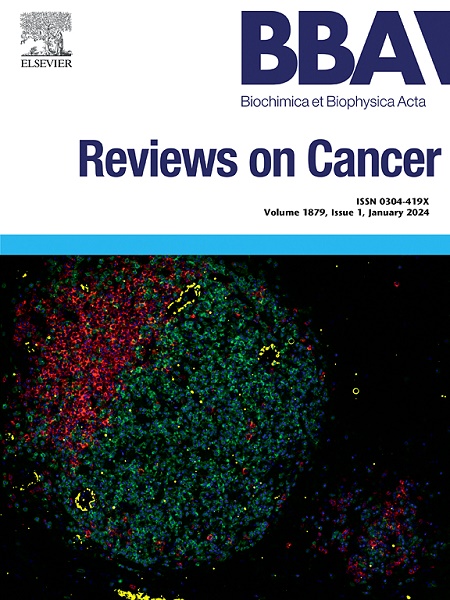肿瘤中stim1介导的钙信号:与肿瘤侵袭性和治疗水平的关系。
IF 9.7
1区 医学
Q1 BIOCHEMISTRY & MOLECULAR BIOLOGY
Biochimica et biophysica acta. Reviews on cancer
Pub Date : 2025-08-13
DOI:10.1016/j.bbcan.2025.189420
引用次数: 0
摘要
钙离子(Ca2+)是肿瘤进展的关键调节因子,通过stim1介导的储存操作钙进入(SOCE)驱动癌症转移和治疗耐药。本文综述了STIM1和ssoce介导的钙信号在不同类型癌症中的作用,重点介绍了我们的重点研究领域口腔癌,并提出了这些领域未来的研究方向。具体来说,这篇综述揭示了STIM1/Orai1复合物激活钙调蛋白(CaM)依赖性效应物以促进上皮-间质转化(EMT)和细胞骨架重塑和免疫抑制微环境的机制。在临床上,STIM1过表达与肿瘤晚期、化疗耐药和不良预后相关,突出了其作为预后生物标志物和治疗靶点的双重作用。尽管临床前研究表明,钙释放活化钙(CRAC)通道抑制剂可抑制肿瘤生长,但钙信号复杂性和组织特异性毒性等挑战仍然存在。未来的研究应结合新兴技术和系统方法,阐明钙信号网络动态调控的机制,最终加快其临床转化和治疗应用。本文章由计算机程序翻译,如有差异,请以英文原文为准。
STIM1-mediated calcium signalling in cancer: Its relation to tumour aggressiveness and therapeutic horizons
Calcium ions (Ca2+), pivotal regulators of tumour progression, drive cancer metastasis and therapy resistance via STIM1-mediated store-operated calcium entry (SOCE). This review focuses on the role of STIM1 and SOCE-mediated calcium signalling in various cancer types, with particular emphasis on oral cancer as a key area of our research, and future research directions in these areas are proposed. Specifically, this review reveals the mechanism by which the STIM1/Orai1 complex activates calmodulin (CaM)-dependent effectors to promote epithelial–mesenchymal transition (EMT) and remodelling of the cytoskeleton and immunosuppressive microenvironment. Clinically, STIM1 overexpression is correlated with advanced tumour stage, chemoresistance, and a poor prognosis, highlighting its dual role as a prognostic biomarker and therapeutic target. Although preclinical studies have demonstrated that calcium release-activated calcium (CRAC) channel inhibitors suppress tumour growth, challenges such as calcium signalling complexity and tissue-specific toxicity persist. Future research should integrate emerging technologies and systematic approaches to clarify the mechanisms underlying the dynamic regulation of calcium signalling networks, which will ultimately accelerate their clinical translation and therapeutic application.
求助全文
通过发布文献求助,成功后即可免费获取论文全文。
去求助
来源期刊

Biochimica et biophysica acta. Reviews on cancer
医学-生化与分子生物学
CiteScore
17.20
自引率
0.00%
发文量
138
审稿时长
33 days
期刊介绍:
Biochimica et Biophysica Acta (BBA) - Reviews on Cancer encompasses the entirety of cancer biology and biochemistry, emphasizing oncogenes and tumor suppressor genes, growth-related cell cycle control signaling, carcinogenesis mechanisms, cell transformation, immunologic control mechanisms, genetics of human (mammalian) cancer, control of cell proliferation, genetic and molecular control of organismic development, rational anti-tumor drug design. It publishes mini-reviews and full reviews.
 求助内容:
求助内容: 应助结果提醒方式:
应助结果提醒方式:


